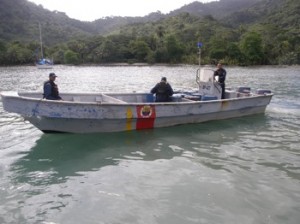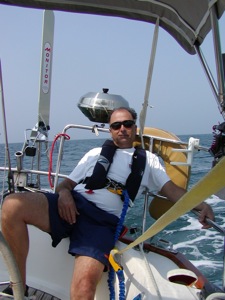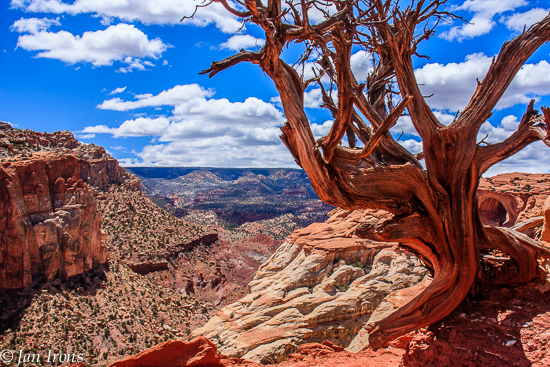We’ve been boarded twice by the Coast Guard – ironically the only time we’ve been stopped and boarded by the US Coast Guard was after we returned from our six year Western Caribbean cruise, just last winter. We were motoring out of Pelican Bay, Cayo Costa and the Coast Guard was stopping boats on their way out of the harbor for safety checks. The first time we were boarded was in Sapzurro, Columbia at anchor when the Guarda la Costa came around to inspect vessels and conduct a search for drugs with a rather large dog. The dog was almost as big as our salon below and we were a bit concerned, but they were very professional and could not have been nicer.

If you notice a large US Coast Guard vessel and then spot a large orange zodiac speeding toward your boat, you are likely going to be subject to a safety check. They will probably want to check the items listed below. This is not a comprehensive list since these depend so heavily on the type of vessel you have, I have not tried to be specific here. But you can download a copy of the Federal Boating Regulations brochure with all the details for every type vessel by clicking here. Scroll to the bottom of the page and click on the very last word “here”.
Also, if you want the US Coast Guard Auxillary to perform a Vessel Safety Check, always recommended so that you know if there’s anything your boat is deficient in, click here.
For a complete list of the US Federal Safe Boating Regulations from the US Coast Guard, visit the USCG Boating Safety Resource Center, click here.
Standard Disclaimer: This information is provided to help you make sure your boat has the necessary equipment and registration/documentation to pass a safety inspection by the US Coast Guard. It is not complete due to the variations in boat types and refers you to the US Coast Guard brochure, see 3 paragraphs above, where all the details are explained in excruciating detail.

Here’s the the Checklist:
1. Federal and/or State Boat Registration or Documentation. If you are a boat with any type of propulsion (i.e. motor, sails or paddle) they will want to see your registration and/or documentation papers. Make sure these are current and not out of date.
2. Federal and/or State Boat Registration or Documentation Numbers Displayed Correctly. Once they’re examined your registration or documentation, they’ll check to see that your numbers are displayed correctly. Depending on the type of boat you have and whether you’re state registered, federally documented or both, the requirements vary widely, so be sure to check the Federal Boating Regulations brochure details by clicking above for the brochure.
3. Life Jackets. All boats must have at least one US Coast Guard approved life jacket for each passenger aboard. If your boat is over 16 feet long, you must also have a throwable Type IV device. Remember, life jackets can only save your life if they’re out, available and/or worn. We always wear our harness inflatable life preservers tethered to the boat when we’re underway overnight, and sometimes during the day if there’s any threat of weather or bouncy seas. They will check to make sure the life jackets are the right size for everyone aboard and in “serviceable” condition by reading the labels to make sure the jackets are US Coast Guard approved so be sure the inside labels on your life jackets or throwable are legible. Life jackets must also be “easily accessible” so make sure they’re not tucked away in some out of the way place or stored in bags or anything similar.
4. Visual Distress Signals. If your boat is operating in US Coastal Waters, the Great Lakes or navigable waters, you must carry the correct US Coast Guard approved Visual Distress Signals and they must be current! Luckily we had enough flares aboard that there were enough that were current, although they were going to be out of date in a few months and they called it to our attention. Visual distress signals, like registration numbers, can vary greatly for varying types of boats, so check the Federal Boating Regulations brochure by clicking on the link above to determine what’s legal for your type boat. The signals must also be in serviceable condition and readily accessible. Ours were tucked back in a locker … they frowned but didn’t say anything. For Winterlude, because we’re a 37′ sailboat with an inboard diesel and we travel overnight, we need to carry 3 day signals and 3 night signals. But check the packaging, some types of flares count for both. It is OK to carry expired flares, just know that they will not count toward the necessary minimum to pass the inspection.
5. Fire Extinguishers. The number of extinguishers varies by the size and type of your boat. Make sure you know what you need! They must be US Coast Guard approved, not expired and be provided with a mounting bracket. Overall they must be either of the B-I or B-II classification and hand portable. While it’s not required, they prefer that the extinguishers are mounted in readily accessible locations such as close to the steering station, engine room or galley – but away from where a fire might actually start. We have two, one is mounted under the nav desk across from the galley adjacent to the engine room and the other is forward in the head in the bow.
6. Engine Ventilation System. Check the brochure – this one is pretty complex. Our boat has dorades on each side of the engine compartment as well as lazarettes that open directly into the compartment. I guess we passed because no one said anything.
7. Backflame Control … this applies to a gasoline powered boat and is beyond my comprehension since we don’t have this issue. Check the brochure for complete information.
8. Sound Producing Devices. We have both a functional hand held air horn – they checked, and a large brass bell. Basically if you’re under 40 feet you must have at least a whistle and if you’re 40 feet or over, you’re required to have a whistle and a bell (and maybe a gong if you’re more than 328 feet!).
9. Navigation Lights. Again, this one is very complex depending on the type of vessel as well as what you’re doing at the time. So check the brochure, but make sure the navigation lights you need are working!
10. Pollution Regulations. You must have an Oil Discharge sticker if you’re over 26 feet and also the capacity to contain oily substances aboard until they can be disposed of properly. Check the brochure for details.
US vessels must also have a placard prominently displayed listing the rules and regulations for garbage. Basically, it is illegal to dump any plastic trash/garbage overboard anywhere in the ocean, coastal waters or navigable waters. Do us all a favor and don’t dump your garbage anywhere – especially in 3rd world countries where they have much bigger problems with garbage than in the US. Keep it aboard until you can dispose of it properly. Garbage can be a problem … make sure you think about a place to store it when it grows beyond your trash container below. We keep extra heavy plastic garbage bags to put the smaller kitchen bags in until we can dispose of them. They’re generally kept in the sail locker away from “smelling distance” I’ll have a post on garbage coming in the next few weeks.

11. Marine Sanitation Devices … i.e. the head. All vessels with an installed head/marine sanitation device must comply with the regulations that apply to their size and type of boat. Aboard Winterlude we have a Raritan PHII head connected to a holding tank with a Y valve that also allows discharge overboard. While in US waters, we must keep the handle locked … here’s what the brochure says:
“padlocking overboard discharge valves in the closed position, using a non-releasable wire tie to hold overboard discharge valves in the
closed position, closing overboard discharge valves and removing the handle, and locking the door to the space enclosing the toilets.”
Our handle was in the closed position (obviously), but was not fastened as required above. They were very nice about it and the officer showed me how to put a wire tie in place to comply with regulations. They also told us that they watch for people running below as the Coast Guard inflatable approaches – so make sure your boat’s ready long before you spot the bright orange inflatable heading for you at full speed!
So there you have it, the 11 critical items that the Coast Guard will be checking for! If you’d like to see the Coast Guard Auxillary’s list of 15 Reasons Why Boats Don’t Pass the Safety Inspection, click here.
The top 3 reasons, based on a survey of over 100,000 voluntary safety inspections?
1. Visual Distress Signals 12%
2. Violating State Regulatsions 10%
3. Navigation Lights 8%
Be prepared! After our boarding, the Coast Guard guys gave us a copy of the form they filled out. Now we have a yellow copy and if we’re stopped again, they said to show it first. They can still choose to board and do an inspection, but may decide not to. OK, we’re ready!
If you’d like to add your Coast Guarding inspection experience, please leave a comment! THX! Jan













